Výstaviště is an exhibition center in Holešovice, a district just north of Prague’s city center. The area has served as the city’s main trade fair and events area since its creation in 1891.
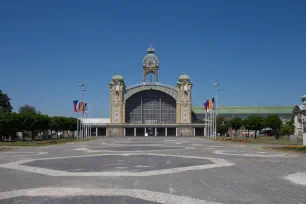
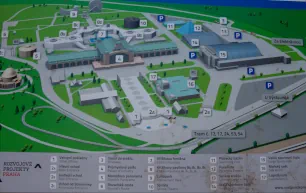
It is particularly popular in summer, when plenty of events are held here and people flock to watch the light and dance show at the Křižík fountain or visit the open air-cinema. There are also sights that attract visitors year-round, such as a concert hall, an aquarium, a historical panorama and a lapidarium. Entrance to the ground is usually free, except during events.
World’s Fair of 1891
Výstaviště was created in 1890 to host the General Land Centennial Exhibition, a world fair that was held the following year to mark the centenary of the first Industrial Exhibition held in Prague in 1791. In a record time of just one year, 140 pavilions were built here and on Petřín Hill. Some 2.5 million people visited the exhibition, which was held from May until October. The exhibitions showed visitors a variety of aspects of life in Bohemia and showed off the industrial and technical prowess of the region. Popular attractions included a fountain illuminated by colored lamps and balloon sightseeing flights.
The Exhibition Grounds Today
Several of the buildings that were erected for the World’s Fair of 1891 survived to this day. They either host attractions or are used for social, cultural, sports and leisure events.
Industrial Palace
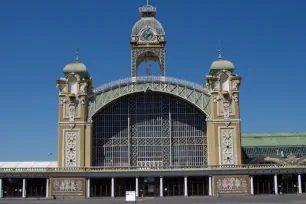

The largest building of the 1891 World Fair was the Průmyslový palác (Industrial Palace), a masterwork in iron and glass. It was designed by the Czech architect Bedřich Münzberger, with the help of his compatriot František Prášil, an engineer who specialized in metal constructions.
The building is an early example of Art Nouveau design. The main facade of the 208-meter-long building consists of two brick towers with Baroque elements, connected by a huge arch that supports a 25-meter-high glass roof. At the center is a domed clock tower that rests on tall stilts. On either side are long side wings. A fire destroyed the left wing in 2008 but its reconstruction started in 2022.
Křižík Fountain
Behind the Industrial Palace is the Křižíkova fontána (Křižík Fountain), named after František Křižík, a Czech engineer who had invented a light fountain that became the star of the 1891 World’s Fair. The fountain was illuminated by electric arc lights that shone through colored glass panes. At the time, the fountain shot water so high in the air that the light could be seen from the Old Town. Today the fountain is not as extreme, but it is still impressive thanks to its 3,000 nozzles and countless color panes. There are scheduled performances in the summer when the fountain’s spectacle is accompanied by music, dance and light shows.
Lapidarium
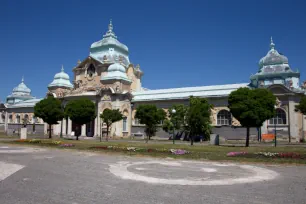
One of the most interesting pavilions from the 1891 World’s Fair was built to house the Retrospective Exhibition, which displayed weapons, armor and monuments. Today the magnificent Renaissance-style building is home to the Lapidarium, a museum of stone sculptures. Here you can admire, among others, original sculptures that once adorned the Old Town Bridge Tower and the Charles Bridge up close.
Sea World
The building that houses the Lapidarium is also home to Mořský Svět (Sea World), an exhibition of marine life with about 360 fish species in a total of 60 aquariums. Highlights include the 100,000-liter shark aquarium, a coral reef, and a unique see-through tank with a capacity of 27,000 liters of freshwater that is home to piranhas, arowanas and oscars.
Marold Panorama
A 12-sided round building just west of the Industrial Palace is home to the Maroldovo Panorama, a 95-meter-wide, 11-meter-high panoramic painting that was created for the 1898 Exhibition of Architecture and Engineering. It depicts the Battle Of Lipany (near Prague), in which moderate Hussites defeated radical Hussites. The current pavilion was built in 1934, on the occasion of the 500th anniversary of the battle.
Other buildings
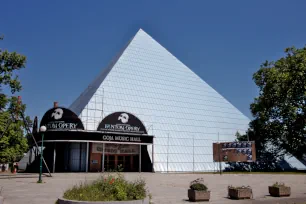
There are many more buildings on the exhibition grounds, such as the Goja Music Hall, a more than 40-meter-tall pyramid-shaped theater/concert hall built in 1991. Opposite the Lapidarium is the Academy of Fine Arts, a building in Neo-Renaissance style. There is also the Spirála – a theater building, Ateliér Rychta – a beautiful Art Nouveau building that provides leisure space for children, as well as a swimming pool, a sports hall, and several event spaces. Finally, there is also the Matějská pouť, a luna park for children situated north of the Industrial Palace. It features plenty of attractions such as a Ferris wheel, a haunted castle, shooting galleries, merry-go-rounds, and so on.

